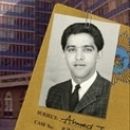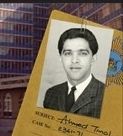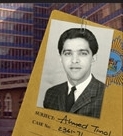Activist brutally murdered by the apartheid regime - RIP {RahimahUllah}
Teacher, member of the South African Communist Party, first political detainee to die at the hands of the Security Police at the notorious John Vorster Police Station, Johannesburg
In February 1970, Timol returned to South Africa. Timol resumed teaching at Roodepoort Indian High School and at the same time embarked on studies for a BA degree through UNISA. In the meantime, he lived with his family, in a tiny cramped flat. This was not to arouse the suspicions of the Security Police, by moving off on his own.
In the meantime, Timol developed the friendship with a former student of his, Salim Essop, studying medicine at Witwatersrand University. The two became very close and were more like brothers. Essop also had abhorrence for Apartheid and the two had long discussions about the political situation in the country.
Timol’s first report back to London was in April 1970, in which he noted that he had compiled a mailing list of 8,000 names and had identified a need for political literature to assist students who were becoming politicised. At the same time, he was identifying candidates for recruitment into the movement for political work. Timol communicated with London and vice versa, several times. In July 1970, he received notice from London of approval for his suggestion of an illegal paper, reflecting the problems of the Indian community and advocating organisation and resistance.
He also began identifying other potential recruits, among them was KC (Kanti) Naik, a science teacher at his school and Indres Moodley, working for a pharmaceutical company in Johannesburg and later as a lecturer at the University College for Indians at Salisbury Island in Durban. Timol was delighted when Moodley moved to Durban, as Moodley could set up a new cell there, under the cover of the University.
Whilst on a trip to Lourenco Maques (now Maputo)] with Faruq Varachia, to watch a soccer match between Portugal and Brazil, he met hid old friends Dr Ahmed Desai (Jakoo) and Yakoob Varachia, both who had come from Durban for the same match. On their return, Varachia was detained and questioned about Timol’s activities in LM. Unbeknown to Timol, he had come to the attention of the Security Police, again.
In his communiqué with London, Timol identified places where letter bombs may be placed. He got a friend, Khadija Chotia (Dija) to type out names and addresses on envelopes. Timol and Salim Essop then posted the envelopes that contained political pamphlets. The pair had successfully distributed pamphlets for a period of 18 to 20 months without being caught. In this period, Timol was quite busy setting up underground structures, producing and distributing pamphlets, procuring photographic, printing equipment and other equipment.
In October 1971, Timol and Salim Essop were arrested at a roadblock in Coronationville, handcuffed and taken to the Newlands Police Station. The police discovered pamphlets in the boot of the car that they were travelling in. According to the police, banned ANC literature, copies of secret communication correspondence, instructions from the SACP, material related to the 50th anniversary of the SACP were found in the car.
Essop was taken to a separate office where he was severely assaulted. The police demanded to know whom they were going to make contact. In reality after a few social visits, the pair was on their way to Mayfair to get a snack. The brutal assault continued. Essop was handcuffed and taken to the notorious John Vorster Square in Johannesburg. His torture had not begun in earnest at the hands of the police.
The police visited the Timol home and detained his father and brother, Haroon. A very large number of people were detained in the wake of Timol’s arrest. Among the arrested was Indres Moodley, with whom Timol had worked closely and who was going to establish an underground cell in Durban. Altogether, the police raided 115 people’s homes. Among those arrested were bishops, priests, lecturers, journalists, students and all members of the executive committee of NUSAS. The Security Police claimed that this was a result of leaflets found in Timol and Essop’s car.
Amina Desai, a close family friend of the Timol family was also arrested. Timol used her home at 12 Harold Street, Roodepoort, as an underground base. This was a second home to Timol, and in return for running errands, Desai would allow Timol use of her car.
Timol also worked with Hilmi, the Desai’s son, and printed leaflets in the Desai garage - an activity of which they were unaware. Desai and Timol were said to have spent hours discussing politics, and she suspected that her telephone was tapped as telephone technicians would frequently visit her home.
Desai was taken to John Vorster Square where she was forced to stand for 52 hours without any sleep and interrogated. Another detainee, Hassen Jooma, was taken to a room where he found tufts of hair and blood on the floor. He realised that it was Timol’s hair and blood. Jooma was given a broom and a bucket and told to clean the floor. After three weeks in solitary confinement, Jooma was released. Indres Moodley was detained for over a month and subjected to severe torture.
Salim Essop was tortured continuously for four days. He had to endure severe assaults. During the course of his torture, he managed to catch a glimpse of Timol through the door of his interrogation room that was ajar. Timol was not walking normally, had a black hood over his head and appeared to be in severe pain. Essop and some of the other detainees were subject to electric shock. He collapsed on a number of occasions and his interrogators would throw water onto his face. They even urinated on him, laughing as they did. They held him by the ankles and threatened to throw him down a stairwell from the 10th floor of the building. Eventually, Essop was placed on a stretcher and taken to Johannesburg General Hospital. According to the medical staff he was severely assaulted.
In the police version of Timol’s detention, they claimed that he admitted having contact with the SACP in London. The police further claimed that on 27 October 1971, while Timol was alone with a policeman, Sergeant J Rodrigues at John Vorster Square, he rushed to a window, opened it and dived out, landing on Commissioner Street. There was no mention at all of assault or torture meted out on Timol.
Timol’s brother, Mohammed, was not allowed out of detention to attend his brother’s funeral. On 29 October, Timol’s family was given his body for burial. During the washing of the body for burial according to Muslim rites, it was observed that his neck was broken and that his fingernails were taken out and that his elbow was burnt. An undertaker, Mohammed Khan, who saw Timol’s body in the mortuary, observed that his eye was out of its socket, his body was covered in blue marks and that he had burn marks all over his body.
Several thousand people attended his funeral in Roodepoort. Roodepoort came to a standstill. All Indian businesses closed as a mark of respect. There was a heavy police presence at the funeral. They even took photographs as Timol’s body was lowered into the grave.
Even after Timol’s funeral, the security police harassment did not stop. Timol’s sister, Aysha, would be followed by the Security Police as she walked from home to the mosque. After the funeral, the police questioned everyone who was associated with him, further traumatising the community. They would visit the Timol family flat and even search through the dustbins.
On 22 June 1972, the inquest magistrate found that no one was to blame for Ahmed Timol’s death. Effectively, the magistrate ruled that Timol had committed suicide and details of his brutal torture were excluded. Thus the Apartheid state was absolved of all responsibility for Timol’s death in detention.
At a function, Former President Nelson Mandela renamed the Azaadville Secondary School, in Krugersdorp, the Ahmed Timol Secondary School on 29 March 1999.
References
Cajee, I.(2005). Timol-A Quest for Justice.STE Publishers, Parktown, Johannesburg




